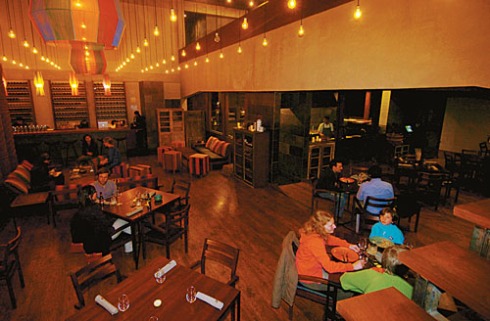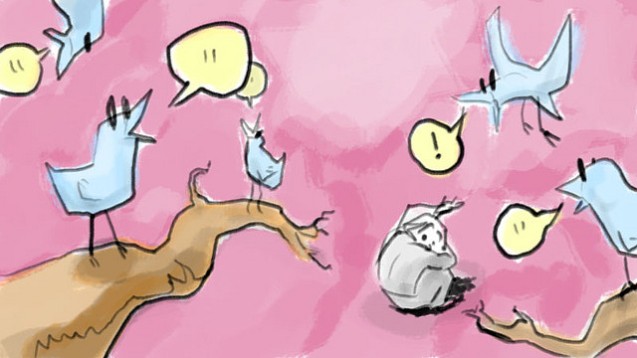A newspaper for annoyed Remain voters that is only intended to run for four issues met with a yawn from the media, looks like an A-Level In-Design project and has no clear editorial agenda. What’s the point?
Strong feelings have been aroused in me by a new newspaper launched last Friday, called The New European. I was made aware of it on the day of its launch when I came across a photo of its cover on Twitter; I then had a read of the press release about it from Archant, a publisher of local newspapers across the United Kingdom, and a look at the media coverage of the launch. I’ve had a stab at reviewing the media coverage, then the design and content – which makes for a long and possibly quite disorganised read. But what are blogs for?

The launch issue cover of The New European
The New European is a weekly newspaper being published under a ‘pop-up’ model, with Archant committing to just four issues and then letting sales figures decide if it continues. Its intended audience is those living in the UK who voted to remain in the European Union: it has been rushed out, from concept to news-stand, in nine days to capture the post-Brexit mood while it lasts. Its first print run was 200,000 copies selling at £2 apiece (or all four issues for six pounds if you subscribe) and editor Matt Kelly, also Archant’s chief content officer, has said that he would be “delighted” if they shifted 50,000 of those.
First, what is a New European? Who knows. No one’s saying.
Having re-launched two magazines as their editor, and being a journalist, I take a serious interest in these things. So I’m disappointed with the lack of interest in the launch from the media itself. I have only come across one in any way substantive article about it – at vice.co.uk – otherwise there has been no thoughtful analysis. Merely, depressingly, cut-and-pasted quotes from Archant’s press release in workmanlike, disinterested news pieces, even from The Guardian‘s Roy Greenslade, whose only job at the paper is to talk about media happenings. Nobody appears to have contacted Archant or Kelly for any insight or comment that goes beyond repeating what is in the press release. Twitter hasn’t lit up about it either. Steve Hewlett, editor and presenter of BBC Radio 4’s The Media Show, broadcast every Wednesday, didn’t see fit to mention The New European in its launch week, though it got a name-check in The World This Weekend two days after it came out – but no mention of the content or response. The Daily Politics gave Kelly a spot, but Andrew Neil’s opening question missed the point, and he seemed to forget that Archant has only committed to four weeks: “So, what do you think are its chances?” Neil’s other guest, Miranda Green, a seasoned hack, editor and founder of a newspaper herself, basically gave a ¯\_(ツ)_/¯ when asked what she thought.
The shrugging text emoji, for the uninitiated, is used in social media contexts to convey feelings of meh-ness, of “nihilism, bemused resignation, and is a Zen-like tool to accept the chaos of universe”. These are sentiments the British voting public know well and that I think plague world-weary media workers too, to the point where too many of them think cutting and pasting from a press release counts as a publishable story. Shrugging text emoji man actually seems to sum up the media response to this launch. The problem is that if the media doesn’t care about the project, it won’t support it, and the newspaper will struggle to keep attracting attention. I’m sure the editor would say that A) its first crop of celebrity columnists is itself media support and B) the paper doesn’t need or desire media support. But that is the world we live in. Actually, Kelly knows that: he’s made sure that the Miranda Sawyers and James Browns are in there, saying anything at all, so they have a reason to tweet about this launch and tell their readers to go and buy a copy (though Sawyer seems to only have managed a re-tweet about it, not commenting herself). On Sunday night, after I tweeted Kelly enquiring as to why he ran a topless photo of one of his contributors, lads mags-era publishing guru James Brown, on the cover, Kelly tweeted back: “because I liked it. it’s a personal indulgence. I’ll pass on your wishes when I see him for breakfast tomorrow”. I’m quite po-faced about that response because it’s defensive and bitchy, not to mention being horribly “famous person A is my mate and that’s why he’s on the cover”, which I find grubby, but predictably media. My boyfriend thinks he was just being sarcastic – he also says I’m picking on the village idiot (the paper, not the editor) and that’s why much of the media has ignored it – but such flippancy would be even less palatable to me than sleb name-dropping.
Armchair experts
The New European presents its crop of media commentators as its ‘experts’ (challenging head on Michael Gove’s infamous comment that “people in this country have had enough of experts”, and right at the top of the cover), but they’re not. They’re hacks. I guess there are different grades of expert. For example, the government has been talking with the ‘Big Four’ consulting firms, mostly known by Average Joe for their skill in helping rich folk and big companies avoid taxes, about helping it navigate the way from Brexit vote to actual EU exit and beyond. Four days before The New European launched, KPMG appointed a head of Brexit, regulatory specialist Karen Briggs, bringing together various colleagues to form a crack team to help worried businesses ready for doomsday. Given that none of us have ever exited the EU before, these firms cannot claim any specific expertise in this area, but that is not an impediment. They are viewed as go-tos by government and business, so view them as your Brexit-makers. It is people like Briggs who The New European should get to contribute, so that readers can hear from the individuals who will really inform the political decisions that will shape our lives and those of our children. I don’t mind Louise Chunn‘s slim piece on women in leadership roles, but there are any number of people who can write on why women are suited to lead in tough times. We’ll find out in the coming months, I guess, whether – as Chunn postulates – “women, especially middle-aged women, have more empathy for others than men”. Her assertions come across as total cod science and are in very dangerous waters well contested by a range of informed commentators. Kelly is right to stick something about women leaders in the paper, given that’s the way it was going while the newspaper was in gestation; and we’re going to endure a lot more of that from the media as May’s premiership gets under way. But it doesn’t strike me as ‘expert comment’ to talk about women in the way someone working at, say, Sterling Cooper Draper Pryce in 1963 might.
Kelly writes in his first editorial that Archant went with the newspaper format over other mediums because “print is committing” – a comment clearly at odds with the pop-up model – then added that, after its four week-long print run, it could turn instead into “a digital platform, or a social media community, or an event.
“Or it may just pass, like the summer wind; no more than a fleeting curiosity in a season of madness”.
Summer wind is a workable cliché here. The editorial approach inside The New European is consciously light-hearted (I wonder if a portion of that is down to its team being drawn entirely from existing Archant staff who are still probably doing their day jobs while contributing). The cover is just bizarre, dominated by a large cartoon of a dog’s thought bubble about stupid voters, and middle-aged publishing eye candy from a topless James Brown – there’s other stuff crammed on there, but it can’t divert my attention from a half-naked man looking like he’s about to start crying because it’s Sunday, he’s run out of croissants and it’s too damp to go on a Sainsbury’s run. I enjoyed his piece on his formative experiences holidaying in Germany and how it formed his European world-view, and I think it’s good that it’s in there. But that cover photo is actually the opposite of what he’s saying: that it’s good to go and explore Europe, not stay back for the comforts of home. It’s a great piece to introduce the more wiffy-waffy cultural half of the newspaper but it’s not right for the cover, and I don’t need to see him de-robed and starved of breakfast breads by the British climate to be compelled to read him. It really undermines the paper’s raison d’etre, which, even if delivered in a light-hearted way, is still very serious – discussing how we’re to shape a future relationship with the EU when we’re outside it and what we’ll lose in so doing, culturally, economically and in formative backpacking trips.
Setting the ‘agenda’
Guardian columnist Jonathan Freedland has the first ‘spread’, of sorts, with a note on the emerging ‘Left Behind’ – Brexiteers who reside in poorer parts of the UK, who allegedly voted to leave as a protest at being left behind by politics and society. His two-column piece is jemmied between three very large images of street demonstrations in the past year or so. The stand-first devotes most of itself to bowing to Freedland’s profile instead of telling me what I’ll gain from reading the piece, and there are no cross-heads in the article, which makes the reading experience a little breathless. The top of each page that carries the name of the sections, called the folio, introduces the 12-page section this piece is in as ‘Agenda’, a well-trodden, safe-as-houses name for a front-of-book section that you don’t really know how to name, but need to make sound vital, ‘newsy’ and authoritative. It means bugger all and can’t really help persuade me that the copy is worth a look, since a weekly newspaper can’t easily deliver ‘newsy’. It cannot set the agenda, or any agenda worth setting, when the main columnist in its launch issue has opened his editorial by writing that the government is without a prime minister, and then six days later, we have Prime Minster May by default. Such is the velocity of things at the moment. So The New European literally carries yesterday’s news. That said, Archant says that each issue should be treated as a collectors’ item. But I can’t see why anyone would look back at this paper versus another well-established one for a set-in-aspic record of such astonishing times as these.

The “What’s on in Europe” spread. Photo @UnitedKingdomEU
The second big editorial spread in Agenda is simply comprised of large-font, space filling quotes from around Twitter, with big screen grabs of a selection of Brexit-themed internet memes: the Teresa May/Game of Thrones one, the shadow cabinet resignation bingo one, the MEP face-palming at Nigel Farage being rude one. The kind of editorial fluff that unpaid, overqualified interns are employed to compile from an easy hour online for the ‘and finally’ or ‘from the web’ corners of a newspaper – one that actually has to earn its keep every day or week – takes a starring role in the launch issue of The New European. Pages 8 through 11 carry what those in publishing usually call ‘nibs’ – 50-word articles – in a column all the way down the left and right hand sides of each spread, the purpose of which is not explained, but seems to be a roll call of interesting things that have happened around the EU. Some are genuinely interesting nuggets for post-work drinking banter. I now know that in The Netherlands, national carrier KLM has developed a trolley that can dispense draught beer at high altitude, but has not yet received the necessary permission to use it. Then there are irrelevant factoids such as German band Beginner launching its international tour.
Towards the back half, after its slew of superstar columnists where most editors think their readers are starting to get weary, is much of the ‘celebrating Europe’ stuff you can flick through half-asleep on the Tube. It’s much more magaziney than newspapery. There’s a page devoted to a photography competition seeking images of Europe; a spread devoted to “What’s on in Europe”’; a piece by young journalist Josh Barrie – he has no byline and I’d never heard of him, but Twitter says he’s online editor for Town & Country House – about his jaunt around some of Europe’s more quaint backpacking attractions way back in 2011; a spread of smart-phone photos taken last week in Glasgow; a piece about watching the footy in Prague and a listicle of the ten best cafes in Paris. A sort of Metro newspaper for the metropolitan, Eurostar and EasyJet generation (that’s me), but not just the social media generation, suddenly giving-a-shit 48 percent, then? Yes, but then a map of The New European‘s subscriber base tweeted by Kelly suggests that subscriptions have been taken out in very many non-metropolitan areas of Britain, including Plymouth, Norwich, Chester, the Kent coast and south Wales.

The New European’s subscriber map. Photo @mk1969 (Editor Mark Kelly)
Columnists Suli Breaks, Ajit Niranjan and Jonathan Freedland are saying the same thing from different perspectives. Wouldn’t it have been a better use of their copy to create a big four page feature comprising all three articles about the topic of the relationship between Remainers and Brexiteers, and how and why Remainers can and should reach out to them, to lead the way forward, whatever your background? That could have been a strong and diverse cover, a call-to-arms. But instead – surprise! – the white, middle aged, famous media type gets the first spread on page 4 and the not-white, younger, less established writers saying the same thing languish together on page 19.
Demonstrating integrity
Inconsistent use of and incomplete bylines is poor practice and it means I can’t tell sometimes what is what, so integrity is called into question. Some articles have detailed bylines (Jonathan Freedland; Dr Paddy Hoey, Osman Ahmed) and others carry nothing but the author name. So I can’t tell if the pieces on pages 8-9 are ‘letters‘ sent in by concerned and opinionated readers, or commissioned articles by journalists? Both have the email address letters@theneweuropean.co.uk sitting directly under the author names. I don’t know if this is saying that these are independent opinions sent in by readers and the editor is inviting more, or if it’s saying that these are articles written by journalists and the editor invites readers to respond. The first on the spread, written by Angela Jameson and spanning both pages, is about jobs being under threat in Hull because agreements to build wind farms have been put on hold after the Brexit vote. Who is Angela Jameson? Why does her letter deserve almost two pages? If she is writing a letter – not a column – she must be a business leader, perhaps a consultant? Nope! She’s another hack (sorry – ‘expert’). The second letter/article, about English Remainers who are threatening to move to Scotland, is by Mark Nicholls. Who he, you ask? Yup! A freelance journalist who runs a news and features agency. I literally have no idea what either the title or the stand-first on a piece about the Tour de France piece means so I haven’t been persuaded to read it – and who is Michael Bailey, the author? He’s one of Archant’s sports writers, Twitter tells me – hence the subject matter. So say that in his byline!
This authenticity thing. I have no problem with journalists writing things – if I did I’d be out of a job – I just want The New European to be clear why people are writing things because context is so important. There are articles on things like the idea of reintroducing Lynx to rural Britain, on something called Tauromania, and a piece by a bloke called Steve Snelling about the Polish in Britain that only state the author name and no information that explains why it is them writing and not some other hack.
Perhaps this is not poor design and signposting, but just that Archant and Kelly don’t think readers care much who is writing or what their legitimacy is. I’m coming at this as a curator of communities around magazines and their brands, where enfranchising your readers by connecting them to your contributors – making them your contributors too – is the goal. You need to demonstrate legitimacy and transparency to deliver that, which means crystal clear and complete contributor bylines, stand-firsts, making sure readers understand who they’re reading and why and how they can get in touch to agree or disagree with these views. Legitimacy can be found in famous contributor names, but Miranda Sawyer’s views on Brexit are no more valuable than my mum’s just because I know her name. She isn’t an expert. Repeat after me, everybody: hacks are not experts. They collect, collate, understand, distil and communicate other people’s experiences and opinions in ways their readers can access, enjoy and learn from. They are not experts when it comes to a newspaper talking about Brexit and calling the section where much of this comment is housed ‘Expertise’ is just pushing it a bit too far. Calling the section for James Brown’s piece ‘Eurofile’ comes across dated – I get the play on words but wouldn’t something like ‘Citizen’ or ‘The European’ be a bit slicker and more focused on the person writing than the newspaper acting as a file of stories of people who like Europe? But that is a very personal thing, and section names can cause very intense debates.
Perhaps a newspaper with a four-week life may simply not think like that. But I don’t think life expectancy or medium excuses these simple housekeeping rules on reader experience.
A final whine. The outside back page with 48 facts about something to do with the number 48. Please, no no no. Stop it. It’s screaming ‘we didn’t know what to do with this page’ to me. You want people to pay for the newspaper over the next three weeks, either on the day or by subscription. Stick a house ad there. If someone reads and enjoys the paper and then see on the final page how they can subscribe or share their views on it, they can get on their smart-phone and do it while the mood takes. That page should work harder for the project than 48 things about the number 48, though at least now I know how how old Kylie is.
The New Day, which lasted barely three months and had an apolitical agenda just as The New European has taken, is still fresh in the memory. What was the point? Launching on the back of the Brexit vote result shock but stating that it is not a political paper and will not invite politicians to contribute, nor write about the political processes involved, is a strange decision for a newspaper trying to capture the mood of millions of people who are pissed off about the most important political event for the UK of the new millennium. And please, por favor, bitte, s’il vous plait, per favore, proszę – Matt Kelly, stop telling people you’re capturing “the zeitgeist” or that you’re being “zeitgeisty”.There is already barely a wet cigarette paper between being British and any episode of The Day Today right now.


















